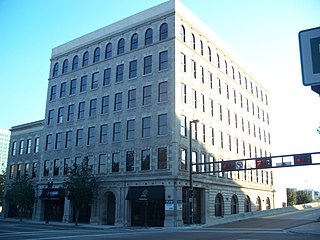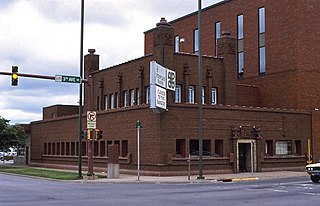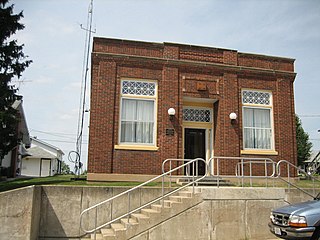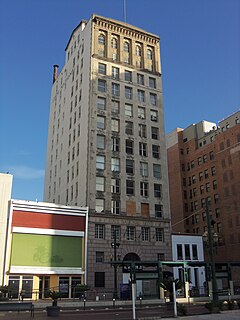
SunTrust Banks, Inc. was an American bank holding company with SunTrust Bank as its largest subsidiary and assets of US$199 billion as of March 31, 2018. The bank's most direct corporate parent was established in 1891 in Atlanta, where it was headquartered.

The Brooklyn Trust Company was a New York City bank.

20 Exchange Place is a skyscraper in the Financial District of Lower Manhattan in New York City. Completed in 1931, it was designed by Cross & Cross in the Art Deco style as the headquarters of the City Bank–Farmers Trust Company, predecessor of Citigroup. The building, standing at approximately 741 feet (226 m) with 57 usable stories, was one of the city's tallest buildings and the world's tallest stone-clad building at the time of its completion. While 20 Exchange Place was intended to be the world's tallest building at the time of its construction, the Great Depression resulted in the current scaled-back plan.

The Dyal–Upchurch Building is a six-story, 43,747-square-foot historic building in Jacksonville, Florida. It is located at 4 East Bay Street, and was designed by architect Henry John Klutho. On April 17, 1980, it was added to the U.S. National Register of Historic Places.

The Peoples Savings Bank in Cedar Rapids, Iowa, was designed by Louis Sullivan. It was the second of a number of small "jewel box" banks in midwest towns designed by Sullivan during 1907 to 1919. It was built in 1911, and it was individually listed on the National Register of Historic Places in 1978. In 2014 it was included as a contributing property in the West Side Third Avenue SW Commercial Historic District.

Wilmington Trust is one of the top 10 largest American institutions by fiduciary assets. Wilmington Trust is currently a provider of international corporate and institutional services, investment management, and private banking. The firm was founded on July 8, 1903, as a banking, trust, and safe deposit company by DuPont president T. Coleman du Pont. In 2010, it became a subsidiary of M&T Bank.

National American Bank Building is a 23-story 325 feet (99 m)-tall skyscraper in the Central Business District of New Orleans, Louisiana, It was completed in 1929 and listed on the National Register of Historic Places in 1986. It is topped with a distinctive 6-story octagonal tower with a golden Art Deco finial. Its address is 200 Carondelet Street. Originally a commercial building it was renovated for use as a residential building after Hurricane Katrina.

48 Wall Street, formerly the Bank of New York & Trust Company Building, is a 32-story, 512-foot-tall (156 m) skyscraper on the corner of Wall Street and William Street in the Financial District of Lower Manhattan in New York City. Built in 1927–1929 in the Neo-Georgian and Colonial Revival styles, it was designed by Benjamin Wistar Morris.

55 Wall Street, also formerly known as the National City Bank Building, is an eight-story building on Wall Street between William and Hanover streets in the Financial District of Lower Manhattan in New York City. The lowest three stories were built in 1836–1841 as the four-story Merchants' Exchange and designed by Isaiah Rogers in the Greek Revival style. Between 1907 and 1910, McKim, Mead & White removed the original fourth story and added five floors.

The People's State Bank building is located in the Stephenson County village of Orangeville, Illinois, United States. The structure was erected in 1926 when two Orangeville banks merged to form the People's State Bank. It operated until 1932 when it became overwhelmed by an economic disaster caused by the Great Depression and the bypassing of downtown Orangeville by an important route. The building is cast in the Commercial style and features Classical Revival detailing, common for banks of the time period. The building was added to the U.S. National Register of Historic Places in 2004.
Jarvis Hunt was a Chicago architect who designed a wide array of buildings, including railroad stations, suburban estates, industrial buildings, clubhouses and other structures.

Davenport Bank and Trust Company was for much of the 20th century the leading bank of the Quad Cities metropolitan area and the surrounding region of eastern Iowa and western Illinois. It was at one time Iowa's largest commercial bank, and the headquarters building has dominated the city's skyline since it was constructed in 1927 at the corner of Third and Main Streets in downtown Davenport, Iowa. It was acquired by Norwest Bank of Minneapolis in 1993 and now operates as part of Wells Fargo following a 1998 merger of the two financial institutions. The historic building was listed on the National Register of Historic Places in 1983 under the name of its predecessor financial institution American Commercial and Savings Bank. In 2016 the National Register approved a boundary increase with the Davenport Bank and Trust name. It was included as a contributing property in the Davenport Downtown Commercial Historic District in 2020. It remains the tallest building in the Quad Cities, and is today known as Davenport Bank Apartments as it has been redeveloped into a mixed-use facility housing commercial, office and residential space.
Mowbray and Uffinger comprised an architectural partnership in New York City formed in 1895. Known for bank buildings and as vault engineers they designed over 400 banks in the pre-World War II era throughout the country. The principals were Louis Montayne Mowbray (1867-1921) and Justin Maximo Uffinger Sr. (1871-1948).

The Cattle Bank is a historic bank building located at 102 E. University Ave. in Champaign, Illinois. Built in 1858, it is the oldest documented commercial structure in Champaign. It opened as a branch of the Grand Prairie Bank of Urbana, Illinois. Champaign was the southern terminus of a railroad line to Chicago, so cattle raisers from the surrounding area drove their cattle to Champaign to ship them to the Chicago market. The Cattle Bank provided banking and loan services to these cattlemen. The building housed a bank for only three years. During that time, U.S. President Abraham Lincoln is known to have cashed a check there. From 1861 to 1971, the building housed several commercial tenants. It was added to the National Register of Historic Places in 1975 and renovated in 1983. Since 2001, the Cattle Bank has been home to the Champaign County History Museum.

The State National Bank Building is a high-rise office building located at 412 Main Street in downtown Houston, Texas. Designed by architect Alfred Charles Finn, the building was built in 1923 in the Spanish colonial style. It was listed on the National Register of Historic Places on August 11, 1982.

Andrew Russel was a Republican politician and banker, who twice served as Illinois Treasurer and later as Illinois Auditor of Public Accounts (1917-1925), before being convicted along with his partner of illegal banking practices in 1932 and dying in prison.

Farmers and Merchants Savings Bank, also known as Union Savings Bank and First Trust and Savings Bank, is an historic building located in Grand Mound, Iowa, United States. It was listed on the National Register of Historic Places in 2001.
CBI Bank & Trust, formerly known as Central State Bank, is a community banking organization based in Muscatine, Iowa. It is a subsidiary of Central Bancshares, Inc., a bank holding company that is also based in Muscatine. Total assets are over $1.1 billion and it employs approximately 230 individuals. The bank traces its origins to 1865 and serves over 43,000 households and businesses with a full range of banking and financial services delivered through 16 banking centers in Coralville, Davenport, Kalona, Muscatine, Walcott, Washington and Wilton, Iowa and Brimfield, Buffalo Prairie, Galesburg and Peoria, Illinois, as well as through a variety of electronic banking channels.

Broadway District is a national historic district located at Hannibal, Marion County, Missouri. The district encompasses 28 contributing buildings in the central business district of Hannibal. It developed between about 1866 and 1934, and includes representative examples of Italianate, Classical Revival, and Art Deco architecture. Notable buildings include the Lakenan Building, Kresge Building (1931), Second Farmers and Merchants Bank, Sproul-Cash Store (1901), Hannibal Trust Company (1909-1910), Hickman Block, and Robinson Brothers.

Farmers Savings Bank is a historic building located in Salem, Iowa, United States. Built in 1916, it replaced a building destroyed by fire the year before. The following banks operated here: Farmers Savings Bank (1916-1933), Farmington State Bank (1936-1944), Des Moines Valley State Bank (1944-1955), State Central Savings Bank (1955-1957), Hillsboro Savings Bank (1957-1976), Hawkeye Bank and Trust (1976-1992). In 1992 Hawkeye Bank and Trust donated the building to the American Legion, who sold it to Anthony and Connie Kramer in 2000. They remodeled the single-story, brick, Neoclassical structure for their home. It was listed on the National Register of Historic Places in 2010.



















